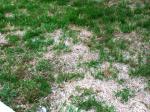COLUMBIA, Mo. – Lawns around the Show-Me State are starting to turn brown. You might believe that disease is the culprit, but in most cases it’s cool-season grasses acting naturally.
“A lot of folks don’t realize that when we have a wet spring where we get rain every three or four days, all that surface moisture means there’s no need for turf grasses to put down deep roots,” said Brad Fresenburg, turf specialist for University of Missouri Extension.
As long as the rain and mold temperatures continue, your lawn will stay lush and green. But when summer brings higher temperatures and less rain, the soil moisture for these shallow roots dries up.
“This puts these grasses into a drought- and heat-stress condition, and they go dormant,” Fresenburg said. “Dormancy doesn’t mean that the grass is dying. It just means it’s going into survival mode until it can get sufficient moisture.”
Fresenburg said people too often see brown areas in their lawn and automatically think “disease.” It’s an understandable reaction, he said. In years when there’s plenty of rain during summer months, fungi can attack grass and cause problems. That is not the case this year because there’s not enough soil moisture to promote fungal growth, he said.
While a browning lawn may be unacceptably unsightly to some, there are advantages to a dormant lawn. Fresenburg said dormant grass is less susceptible to disease and you won’t have to mow it in the heat of the summer. Best of all, he said, it’s temporary.
“As we get into September we may start to see timely rainfall and cool temperatures, and those grasses will come back,” Fresenburg said.
Grasses, as with all plants, have mechanisms that help them survive unfavorable conditions.
“It’s a good thing, too. Otherwise, we’d have a bare Earth,” Fresenburg said.
Related publications from MU Extension available for free download:
Read more http://extension.missouri.edu/news/DisplayStory.aspx?N=1932





